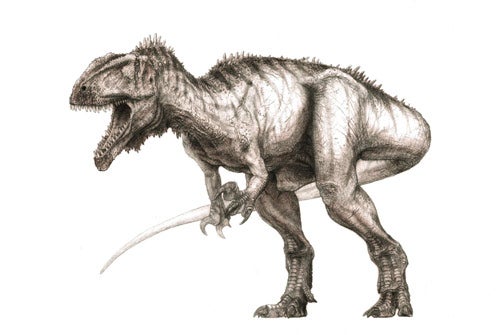'Fierce-eyed' grandfather of T-rex found in Sahara

Your support helps us to tell the story
From reproductive rights to climate change to Big Tech, The Independent is on the ground when the story is developing. Whether it's investigating the financials of Elon Musk's pro-Trump PAC or producing our latest documentary, 'The A Word', which shines a light on the American women fighting for reproductive rights, we know how important it is to parse out the facts from the messaging.
At such a critical moment in US history, we need reporters on the ground. Your donation allows us to keep sending journalists to speak to both sides of the story.
The Independent is trusted by Americans across the entire political spectrum. And unlike many other quality news outlets, we choose not to lock Americans out of our reporting and analysis with paywalls. We believe quality journalism should be available to everyone, paid for by those who can afford it.
Your support makes all the difference.The remains of two meat-eating dinosaurs have been unearthed in the Sahara desert where they once terrorised their prey.
The fossilised bones of the two dinosaurs were excavated during an expedition in 2000 but it is only now that scientists have been able to identify and name them as a newly discovered pair of carnivorous species that lived 110 million years ago.
One of the new dinosaurs is a short-snouted creature that grew to about 25 feet long. Scientists have called it Kryptops palaios, or "old hidden face", because of the horny covering on its snout.
Kryptops may have lived on dead or dying animals in the manner of a modern hyena. Like later members of its group, the abelisaurids of South America and India, Kryptops had short, armoured jaws and small teeth, which were well designed for gobbling guts and gnawing. The other dinosaur, a contemporary of similar size, has been named Eocarcharia dinops or "fierce-eyed dawn shark", because of its blade-shaped teeth and prominent bony eyebrow. Unlike Kryptops, its teeth were more suited to attacking live prey and severing body parts, the scientists said.
Carcharodontosaurids, the group to which Eocarcharia belongs, gave rise to the largest predators on the southern continents, which were as big, if not bigger than a T-rex. Eocarcharia would have made a terrifying adversary. A swollen bony brow over its eye gave it a menacing appearance and may have been used as a battering ram against rivals for mating rights.
The two dinosaurs were discovered by a Bristol University student, Steve Brusatte, who was part of an expedition led by Paul Serano, the renowned fossil hunter at the University of Chicago who has made a number of important finds in north Africa.
"For those of us who work on the dinosaurs of the southern continents, uncovering these fossils is like finding a Neanderthal relative to our own species," Mr Brusatte said.
"They are the earliest records of both major carnivore groups that would go on to dominate Africa, South America and India during the next 50 million years of the Cretaceous period," he added.
Until now little has been known about the early evolution of these two major groups of predatory dinosaur that dominated the southern continents. The latest discoveries reveal that Kryptops, Eocarcharia and another dinosaur – Suchomimus, a large, fish-eating dinosaur that walked on two legs – all lived together and would have made a fearsome troika for any plant-eater to face, Mr Brusatte said.
"It is clear from their anatomy that they were eating different things. Suchomimus ate fish, Kryptops ate smaller animals and Eocarcharia was the top predator of its day," he said.
"Just like in the African savannah today, lions, cheetahs and hyenas must eat different food to survive side by side. It is fascinating to see this in a 110 million-year-old ecosystem."
The fossils found included the jaw bone, pelvic girdle, vertebrae and ribs of Kryptops and several cranial bones and isolated teeth of Eocarcharia. They were recovered from the Elrhaz Formation along the western edge of the Té*éré Desert in Niger in a place known as Gadoufaoua.
Mr Serano and Mr Brusatte formally described the fossils in a study published this week in the journal Acta Palaeontologica Polonica.
Join our commenting forum
Join thought-provoking conversations, follow other Independent readers and see their replies
Comments